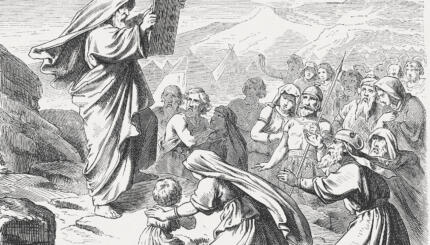Reprinted with permission from Jerusalem Report.
We’re used to seeing Jewish holidays as having two dimensions: history and nature. Even the Sabbath is described as a remembrance both of Genesis, nature’s creation, and of the Exodus, historic redemption. A close look at reveals a third dimension, which carries a very contemporary social message.
The usual history-nature synthesis is clearly seen in the other two pilgrimage festivals of and . Pesach commemorates the people’s birth in the Exodus, along with the spring budding, the rebirth of life in nature. Matzah is the bread of affliction and slavery, and of the hasty flight to freedom; yet it’s also the new grain, as yet unfermented in the nascent springtime. Likewise, the booths of Sukkot hark back to the temporary dwellings of wandering Israelites in the desert, but are also the shacks of field workers bringing in the harvest.
Shavuot, the third pilgrimage holiday, didn’t originally fit the pattern. In the , it’s only a harvest festival. Only later did the rabbis fill in the blank by connecting it to the giving of the Torah, thus situating it between the Exodus and the Wandering. This created symmetry, but more importantly, it was a response to the fact that the historical aspects of the holidays would be much more serviceable for Diaspora culture.

Help us keep Jewish knowledge accessible to millions of people around the world.
Your donation to My Jewish Learning fuels endless journeys of Jewish discovery. With your help, My Jewish Learning can continue to provide nonstop opportunities for learning, connection and growth.
But Shavuot breaks the mold for another reason. In Leviticus 23, one of the Torah’s major accounts of the festival calendar, after the description of the holiday’s Temple rituals (verses 15-21), the text repeats the commandments to leave the corners of the fields and the unharvested gleanings of the crops for the poor. Given the ritual focus of the chapter, this ethical addition is even more remarkable. Commentators, however, generally gloss it as a simple mental association with the harvest season of Shavuot, or as a reminder that there are social obligations beyond the ritual ones.
But there’s a deeper reason. Pesach, with its unleavened bread and dietary restrictions, is clearly in some profound way about food. Sukkot, second only to Pesach in strenuous preparations, focuses on shelter: where, in what, and how you live. Both mandate a form of enforced poverty–eating matzah, the bread of affliction, and living in a shack, the most modest of dwellings. These holidays are great social equalizers. Fulfilling their central obligations to make the wealthy more like the poor, and no one, rich or poor, is excluded by the rituals.
The Biblical Shavuot is different. The celebration focuses on the first fruits and newly harvested grain, and the main celebrants are landowners, those who have grain and fruits to bring. As such this festival is “about” land, a basic element of civilization along with food and shelter. Perhaps ideally, everyone was supposed to be a landowner, but the Torah realizes that this was never going to be the case. The holiday, then, has the dangerous potential of splitting the people between landed and landless. The unexpected verse about leaving parts of the harvest for the poor is a reminder of mutual obligation, a reminder that the land should be a source of justice and not division, that the holiday requires an ethic of care, and not just a celebration of wealth. This is a statement about holidays: gratitude for our bounteous harvests of various types is best expressed through compassion for those who have not been so blessed, not through closed, self-satisfied convocations of the favored.
But the message regarding the land is even more forceful. In contemporary Israel, there is a widening gap between rich and poor, much of it due to differential access to the land and its benefits. We are no longer talking of a few bushels of grain. Real estate is big business. The land has become a commodity, and is traded and speculated rather than husbanded or stewarded. Developers build up dwindling beachfront property, agricultural land is rezoned for upscale residential and commercial complexes, and massive development projects of dubious public value are thrown up. All are a source of profits for some, with many people–and the environment–losing out.
The Biblical land ethic, codified in ritual and ethics, merged the natural with the social by expressing an inseparable link between the land, its bounty, and its continued well-being, and the need for the care and support of all the people.

